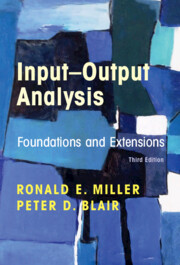Book contents
- Input–Output Analysis
- Input–Output Analysis
- Copyright page
- Contents
- Figures
- Tables
- Preface
- 1 Introduction and Overview
- 2 Foundations of Input–Output Analysis
- 3 Input–Output Models at the Regional Level
- 4 Organization of Basic Data for Input–Output Models
- 5 The Commodity-by-Industry Approach in Input–Output Models
- 6 Multipliers in the Input–Output Model
- 7 Supply-Side Models, Linkages, and Important Coefficients
- 8 Decomposition Approaches
- 9 Nonsurvey and Partial-Survey Methods:
- 10 Nonsurvey and Partial-Survey Methods:
- 11 Social Accounting Matrices
- 12 Energy Input–Output Analysis
- 13 Environmental Input–Output Analysis
- 14 Mixed and Dynamic Models
- 15 Additional Topics
- Postscript
- Book part
- Author Index
- Subject Index
- References
13 - Environmental Input–Output Analysis
Published online by Cambridge University Press: 06 January 2022
- Input–Output Analysis
- Input–Output Analysis
- Copyright page
- Contents
- Figures
- Tables
- Preface
- 1 Introduction and Overview
- 2 Foundations of Input–Output Analysis
- 3 Input–Output Models at the Regional Level
- 4 Organization of Basic Data for Input–Output Models
- 5 The Commodity-by-Industry Approach in Input–Output Models
- 6 Multipliers in the Input–Output Model
- 7 Supply-Side Models, Linkages, and Important Coefficients
- 8 Decomposition Approaches
- 9 Nonsurvey and Partial-Survey Methods:
- 10 Nonsurvey and Partial-Survey Methods:
- 11 Social Accounting Matrices
- 12 Energy Input–Output Analysis
- 13 Environmental Input–Output Analysis
- 14 Mixed and Dynamic Models
- 15 Additional Topics
- Postscript
- Book part
- Author Index
- Subject Index
- References
Summary
Chapter 13 reviews the extensions of the input–output framework to incorporate activities of environmental pollution and elimination associated with economic activities as well as the linkages of input–output to models of ecosystems. The chapter begins with the augmented Leontief model for incorporating pollution generation and elimination, from which many subsequent approaches have been developed. The chapter then describes the now widespread application of input–output analysis to environmental lifecycle assessment and establishing a “pollution footprint” for industrial activity. Environmental input–output is also now widely used to evaluate global environmental issues. The special case of analyzing the relationship between global climate change and industrial activity with a carbon footprint is then explored along with using input–output to attribute pollution generation to the demands driving consumption compared with the more traditional attribution of pollution generation to the sectors of industrial production necessary to meet that demand.
Keywords
- Type
- Chapter
- Information
- Input-Output AnalysisFoundations and Extensions, pp. 601 - 677Publisher: Cambridge University PressPrint publication year: 2022

